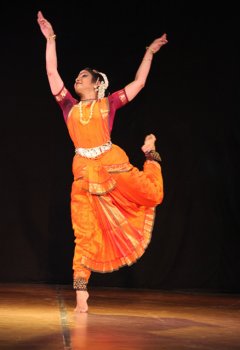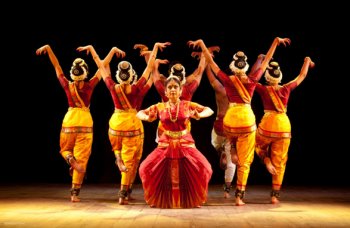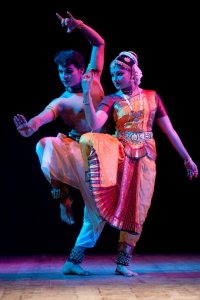
|   |

|   |
Ananda Ramayanam – A Seshan, Mumbai e-mail: anseshan@gmail.com November 26, 2012 Ananda Shankar Jayant and her Shankarananda Kalakshetra troupe presented a Bharatanatyam programme in a two-day dance festival organised by the Sri Shanmukhananda Fine Arts & Sangeetha Sabha, Mumbai, on November 15 and 16, 2012. The first day was devoted to “Tyagaraja Ramayanam.” It was based on the book entitled ‘Thyagaraja Kriti Ramayanam’ by D Seshadri. In her introductory remarks Ananda recalled that, over the years, she had danced to the story of Ramayanam based on the sahityas and poetry of many authors, such as “Bhavayami Raghuramam” of Swati Tirunal. The day’s performance was based on the kritis of Tyagaraja. Valmiki’s shlokas were also used at appropriate places set to music by Subhashini Shankar. It was in the ekaharya (mono-drama) mode with Ananda taking on the roles of different characters from the epic story. It has been an all-time favourite work, both for her and the rasikas, having been choreographed and presented for the first time in 1986. This year marks the tercentenary of the birth of Arunachala Kavirayar, the Tamil poet. I feel it would be appropriate for her to choreograph yet another story of Lord Rama based on his Ramanataka Keertanaikal. I suggested this to her when I met her after the performance. I was encouraged to make the suggestion after having seen such an effort well choreographed and received by rasikas a few days back when the Dhananjayans’ Bharata Kalanjali presented an interesting programme at the National Centre for the Performing Arts.  Photo: Chella Dancing to the sahityas of vaggeyakaras of Carnatic music has been the subject of controversy from time to time. Their suitability for choreography has been questioned by some experts on the ground that they were not designed or composed for dancing. In “Sogasuga” (Sriranjani), Tyagaraja talks about navarasas being one of the essential ingredients of a standard kriti. It is rasanubhava that links music, dance and theatre. Where there is rasa there is dance provided there is scope for displaying the other main features of the classical format. However, one has to be selective in choosing the kritis as all of them may not lend themselves easily to choreography, if full justice is to be done to hasta mudras, abhinaya, etc. It is a challenge to, and a test of, the expertise of a choreographer. Natyarangam, the dance wing of Narada Gana Sabha, Chennai, had a festival with the theme ‘Vaggeyabharatam’ a couple of years ago and demonstrated successfully with the help of eminent dancers the possibilities of adapting select kritis to Bharatanatyam. Ananda was judicious in making the selection limiting herself to certain episodes of the epic that are covered in Tyagaraja’s kritis. They were in two parts - from Rama's birth to Sita Kalyanam and from Bharata's search for Rama to the final coronation of the latter in Ayodhya. Some of the episodes that were well depicted were the lifting of Siva Dhanush by Rama, the amorous advances of Surpanaka and her nose being cut, Sabari moksham, and the Pattabhishekam. The movements of the monkeys constructing the bridge to Lanka were thoughtfully choreographed in the form of suddha nrittam. The songs were interspersed with the use of jatis rendered strongly. The transition from one character to another was smooth. Ananda has expressive eyes that augment her mukhajabhinaya.  Photo: G Murali It was interesting to note how the kritis provide scope for the navarasas to be expressed. Sringara has three sub-categories – bhakti, vatsalya and rati. The former two were featured. The only missing rasa was rati sringara. There is a kriti in Kalyanavasantam (“Kanulutakani”), which is appropriate for the expression of rati sringara. Unfortunately one does not hear it in the concert circuit as it has been overshadowed by its more popular cousin “Nadaloludai.” Ananda may like to consider this kriti for inclusion in dance in the future. The only disappointment for the rasikas was that it was all over in 45 minutes making them ask for more! But it was made up on the next day with a longer and diversified programme. The second day saw “Nrityopahara” with group choreographies that included Surya Namaskaram, Dashavataram, Vasanta - India in spring - and Shivoham besides a solo dance item based on an Annamacharya composition. Surya Namaskar was an ode to the life-giving quality of the Sun God and incorporated a mix of yoga and kalari (martial) movements.The tanam format was a novelty. In Dashavataram in Ragamalikai, I found the Narasimha Avatar done tastefully. Generally, in other performances, I have found the artiste developing a tendency to overact with a protruding tongue and fearful body movements reminding one of a Rottweiler attacking its victim. Ananda portrayed it showing sobriety though it was an act of violence on the part of Narasimha! The Annamacharya kriti on Alarmel Manga (Shringara Darpanam) was one of the rare 108 pieces of the vaggeyakara to which Ananda danced. Prakriti-Vasanta was a tribute to Gurudev Rabindranath Tagore’s influence on Telugu litterateurs. The choreography was done on the well-known Telugu poet Devullapalli Krishnasastry’s poetry on nature for whom nature and seasons are an embodiment of life. The penultimate two pieces were a Meera bhajan and a tillana.The Tillana in Natabhairavi, rarely heard outside Kalakshetra, is a poetic and musical offering of gratitude composed by Veena Krishnamachariar to Rukmini Devi, who established Kalakshetra and started a renaissance movement for Bharatanatyam.  Photo: G Murali The climax of the two days’ programme was the last item “Shivoham” – the cosmic dance with Siva’s tandavam and Shakti’s lasyam each complementing the other. Nataraja, Lord Shiva, resides on the serene and beautiful mountain tops in the mighty Himalayas at Kailasha. He and His consort Shakti together are Ardhanarishvara and represent the synthesis of the masculine and feminine energies of the universe illustrating how the female principle of God, Shakti, is inseparable from Shiva, the male principle. Dancing together, they symbolize the cosmic cycles of creation and destruction, as well as the daily rhythm of birth and death. The dance was a pictorial allegory of the five principal manifestations of eternal energy - creation, destruction, preservation, salvation, and illusion, presented through devotional poetry and rhythmic mnemonics, that created roaring waves of resounding beauty projecting a vision of primordial energy. It was the ultimate triumph of choreography that was reinforced by the powerful and vibrant rendition of jatis by Ananda that reminded me of the master nattuvanars of the past. It was the piece de resistance of the two-day event. The costumes were simple and attractive on both the days without distracting attention. In the group dances considerable practice and training in the coordinated movements of hands and feet were evident. The dancing group consisted of Sneha Magapu, Krithika Varsha, Aparna Sharma, Chelna Galada, Aditi Rao and Jinak Raj. Ananda, Sneha and Aparna handled nattuvangam.The orchestral support was an additional factor for the success of the programme. It was provided by S Venumadhav (vocal), T P Balasubramanyam (mridangam) and K Saikumar (violin) while the lighting arrangements were by Surabhi Purna Chandrashekar. Ananda holds a Master’s degree in Ancient Indian History (where she topped in her university), an M.Phil in Art History and a Ph.D. in Tourism. She actively lectures on issues of breast cancer support, having successfully battled the illness over the last two years. Hers is the successful saga of the triumph of the spirit over the body. In addition to Bharatanatyam she is adept at Kuchipudi also. The audience was surprised when Secretary Amarnath Sury announced that she was Chief General Manager of the Indian Railway Traffic Service in Secunderabad. It is remarkable that she pursues her artistic works in India and abroad successfully while attending to heavy administrative work in office. The railway administration should be congratulated for encouraging her by providing her space for her activities through the leave of absence from duty. The auditorium with a capacity to hold 3000 persons was fairly well occupied. It was remarkable because the city was in the grip of a tension due to the news that Balasaheb Thackeray, leader of Shiv Sena, was seriously ill. There was considerable dislocation of transport with many autorickshaws and taxis refusing to ply their vehicles. That, despite all these problems, so many rasikas turned out to see Ananda’s programme testified to her popularity as well as the art form. Interviewed by Lalitha Venkat of narthaki.com, Ananda once said that her worry was why dance audiences were mostly bald or old. She asked, “Where are the youngsters - the 20-something Generation Next? If this continues, what will happen 20 years hence?” The answer is simple. In twenty years, today’s youngsters would become bald and old and start taking interest in our classical music and dance! The author, an Economic Consultant in Mumbai, is a music and dance buff. |